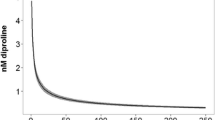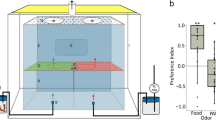Abstract
Animals must search for other individuals under spatially and temporally fluctuating environments. During mate searches, search timing is critical to increase encounter rate and internal oscillating clocks often play important roles in synchronization. On the other hands, some species living in areas with no or reduced periodicity do not show endogenous circadian rhythm, where little is known about how they determine search timing. Termites usually live within logs and underground with little light fluctuations, but also come out of their nests during mating flight season. After swarming, termites run on the ground to search for mates. If they fail to find mates on the flight day, they need to continue searching until a day to succeed. Here we found that unpaired termites show daily search–rest cycles and restrict searching activity to a certain period of the day by responding to photic cycles. The search–rest cycles were diel rhythmic and synchronized with light–dark cycles. Termites also showed periodic (period length ≈ 18 h) search–rest patterns under constant darkness. These results indicate that the diel rhythm is caused by the internal oscillating clocks which are entrained to the photic cycles. The search activity in light–dark cycles was observed only at a specific time during the light period, which matches approximately the time of swarming flight. Our results suggest that termites adaptively regulate their daily searching activity, if they fail to encounter mates at the flight day.


Similar content being viewed by others
References
Absuhama FT, Al Houty WA (1989) Diurnal activity rhythms of the subterranean termite Anacanthotermes vagans (Hagen) under laboratory and field conditions of the Kuwait desert. Int J Biometeorol 33:12–18
Akaike H (1974) A new look at the statistical model identification. IEEE Trans Autom Control 19:716–723
Bell WJ (1990) Searching behavior patterns in insects. Annu Rev Entomol 35:447–467
Bloch G, Barnes BM, Gerkema MP, Helm B (2013) Animal activity around the clock with no overt circadian rhythms: patterns, mechanisms and adaptive value. Proc R Soc Lond B 280:20130019
Bowler DE, Benton TG (2005) Causes and consequences of animal dispersal strategies: relating individual behaviour to spatial dynamics. Biol Rev 80:205–225
Chouvenc T, Helmick EE, Su N-Y (2015) Hybridization of two major termite invaders as a consequence of human activity. PLoS One 10(3):e0120745
Deligne J, Quennedey A, Blum M (1981) The enemies and defense mechanisms of termites. In: Hermann H (ed) Social insects. Academic Press, New York, pp 1–76
Eban-Rothschild A, Belluci S, Bloch G (2011) Maternity-related plasticity in circadian rhythms of bumble-bee queens. Proc R Soc Lond B 278:3510–3516
Fuchikawa T, Matsubara K, Miyatake T, Matsuura K (2012) Acoustic emission monitoring of the effect of temperature on activity rhythms of the subterranean termite Reticulitermes speratus. Physiol Entomol 37:303–308
Groot AT (2014) Circadian rhythms of sexual activities in moths: a review. Front Ecol Evol 2:43
Henderson G, Delaplane KS (1994) Formosan subterranean termite swarming behavior and alate sex-ratio (Isoptera: Rhinotermitidae). Insect Soc 41:19–28
Johnson JN, Hardgrave E, Gill C, Moore D (2010) Absence of consistent diel rhythmicity in mated honey bee queen behavior. J Insect Physiol 56:761–773
Lloyd M, Dybas HS (1966) The periodical cicada problem. II. evolution. Evol Int J org Evol 20:466–505
Maekawa K, Mizuno S, Koshikawa S, Miura T (2008) Compound eye development during caste differentiation in the termite Reticulitermes speratus (Isoptera : Rhinotermitidae). Zool Sci 25:699–705
Matsuura K, Nishida T (2001) Comparison of colony foundation success between sexual pairs and female asexual units in the termite Reticulitermes speratus (Isoptera: Rhinotermitidae). Popul Ecol 43:119–124
Matsuura K, Nishida T (2002) Mechanism, induction factors, and adaptive significance of dealation in the subterranean termite Reticulitermes speratus (Isoptera, Rhinotermitidae). Insect Soc 49:241–244
Miyatake T (2011) Insect quality control: synchronized sex, mating system, and biological rhythm. Appl Entomol Zool 46:3–14
Mizumoto N, Yashiro T, Matsuura K (2016) Male same-sex pairing as an adaptive strategy for future reproduction in termites. Anim Behav 119:179–187
Petris G, Petrone S, Campagnoli P (2009) Dynamic linear models with R. Springer, New York
R Core Development Team (2015) R: a language and environment for statistical computing. R Foundation for Statistical Computing, Vienna. https://www.r-project.org/. Accessed 10 June 2017
Refinetti R (2004) Non-stationary time series and the robustness of circadian rhythms. J Theor Biol 227:571–581
Refinetti R, Cornélissen G, Halberg F (2007) Procedures for numerical analysis of circadian rhythms. Biol Rhythm Res 38:275–325
Sakai T, Ishida N (2001) Circadian rhythms of female mating activity governed by clock genes in Drosophila. Proc Natl Acad Sci USA 98:9221–9225
Saunders DS (2002) Insect clocks, 3rd edn. Elsevier, Amsterdam
Scharf I, Kotler B, Ovadia O (2009) Consequences of food distribution for optimal searching behavior: an evolutionary model. Evol Ecol 23:245–259
Sharma V, Lone S, Goel A (2004) Clocks for sex: loss of circadian rhythms in ants after mating? Naturwissenschaften 91:334–337
Takematsu Y (1999) The genus Reticulitermes (Isoptera: Rhinotermitidae) in Japan, with description of a new species. Entomol Sci 2:231–234
Tucker VA (1970) Energetic cost of locomotion in animals. Comp Biochem Physiol 34:841–846
Vargo EL (2003) Hierarchical analysis of colony and population genetic structure of the eastern subterranean termite, Reticulitermes flavipes, using two classes of molecular markers. Evol Int J org Evol 57:2805–2818
Vargo EL, Husseneder C (2009) Biology of subterranean termites: insights from molecular studies of Reticulitermes and Coptotermes. Annu Rev Entomol 54:379–403
Yerushalmi S, Green RM (2009) Evidence for the adaptive significance of circadian rhythms. Ecol Lett 12:970–981
Acknowledgements
We thank Tomonari Nozaki for assistance, Tatsuya Inagaki, Jun Uto and Saki Yanagihara for helping termite collection. We also thank Dr. Shigeto Dobata for fruitful discussion about the statistical analysis. We thank two anonymous referees who significantly improved the manuscript. Subtropical Field Science Center (Yona Field) of University of the Ryukyus provided the study field. This study was supported by a Research Fellowship for Young Scientists from the Japan Society for the Promotion of Science (JSPS) No. 15J02767, and Japanese Society for the Promotion of Science Kiban Kenkyu S Grant 25221206.
Author information
Authors and Affiliations
Corresponding author
Rights and permissions
About this article
Cite this article
Mizumoto, N., Fuchikawa, T. & Matsuura, K. Pairing strategy after today’s failure: unpaired termites synchronize mate search using photic cycles. Popul Ecol 59, 205–211 (2017). https://doi.org/10.1007/s10144-017-0584-3
Received:
Accepted:
Published:
Issue Date:
DOI: https://doi.org/10.1007/s10144-017-0584-3




